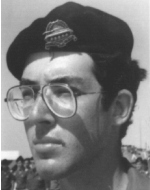Wolfson, Eyal
Son of Ilana and Joseph. He was born on April 5, 1965, in Kibbutz Afikim, where he grew up in elementary school and later went on to study at the Beit Yerah Regional High School in the Jordan Valley. , Traveled with his parents to the United States to stay in the United States for two years, during which he studied at Farmdale High School in Long Island, New York.In spite of the difficulties of language and adaptation, the sense of foreignness and longing for friends in Israel received a distinction for his extraordinary achievements in studies, Who is Who, “which includes a list of most prominent students from high school students in the United States. He was able to work alone for long hours in building and assembly games, with an inner concentration, imagination and creativity, and a great ability to read, read books, loved to paint, and later became interested in his peers and other pursuits such as sports and computers. During his stay in the United States, he returned to Israel with his sister and joined his classmates in Beit Yerah, who went on a youth delegation to Germany. Eyal was drafted into regular service in November 1983 and joined the Armored Corps for training in the Golan Heights. After basic training he underwent a mechanical engineering course, a tank commander course, and later an officers’ course and became commander of the tank division. He did most of his regular service in the Golan Heights. In November 1986, he began his career as a company commander and during his service he served as a company commander and served for about a year as a company commander, during which he served in the Armored Corps in the Golan Heights and was brought to rest on the 17th of Nissan 5748 (14.4.1988) In the military section of the Kibbutz Afikim cemetery, where he was succeeded by his parents, brother and sister Moshe and Galia, who was promoted to the rank of captain, and in his letter of condolences to the bereaved family, his commander writes about how he performed complex tasks, Eyal played this role in practice and served as the commander’s right hand at work and in command of the battalion. The kibbutz published a booklet in his memory. In a booklet of letters and illustrations from his estate, some of which were made by a ram and written by his mother, his teammates, his commanders and his comrades.
